Cytokeratin 8 Recombinant Rabbit Monoclonal Antibody [SU0338]

cat.: ET1608-32
| Product Type: | Recombinant Rabbit monoclonal IgG, primary antibodies |
|---|---|
| Species reactivity: | Human, Mouse, Rat |
| Applications: | WB, IF-Cell, IF-Tissue, IHC-P, IP, FC |
| Clonality: | Monoclonal |
| Clone number: | SU0338 |
| Form: | Liquid |
| Storage condition: | Shipped at 4℃. Store at +4℃ short term (1-2 weeks). It is recommended to aliquot into single-use upon delivery. Store at -20℃ long term. |
| Storage buffer: | 1*TBS (pH7.4), 0.05% BSA, 40% Glycerol. Preservative: 0.05% Sodium Azide. |
| Concentration: | 1ug/ul |
| Purification: | Protein A affinity purified. |
| Molecular weight: | Predicted band size: 54 kDa |
| Isotype: | IgG |
| Immunogen: | Synthetic peptide within Human Cytokeratin 8 aa 321-370 / 483. |
| Positive control: | Hela cell lysate, A431 cell lysate, Hela, MCF-7, A431, human breast carcinoma tissue, human breast tissue, human liver tissue, mouse liver tissue, rat liver tissue, SK-Br-3, HepG2. |
| Subcellular location: | Nucleoplasm, Nucleus matrix, Cytoplasm. |
| Recommended Dilutions:
WB IF-Cell IF-Tissue IHC-P FC IP |
1:1,000-1:2,000 1:400-1:800 1:400-1:800 1:1,000-1:1,500 1:500-1:1,000 Use at an assay dependent concentration. |
| Uniprot #: | SwissProt: P05787 Human | P11679 Mouse | Q10758 Rat |
| Alternative names: | CARD2 Cell proliferation inducing gene 46 protein Cell proliferation inducing protein 46 CK 8 CK-8 CK8 CYK8 Cytokeratin 8 Cytokeratin-8 K2C8 K2C8_HUMAN K8 Keratin 8 Keratin keratin type II cytoskeletal 8 Keratin-8 KRT8 type II cytoskeletal 8 Type-II keratin Kb8 |
Images
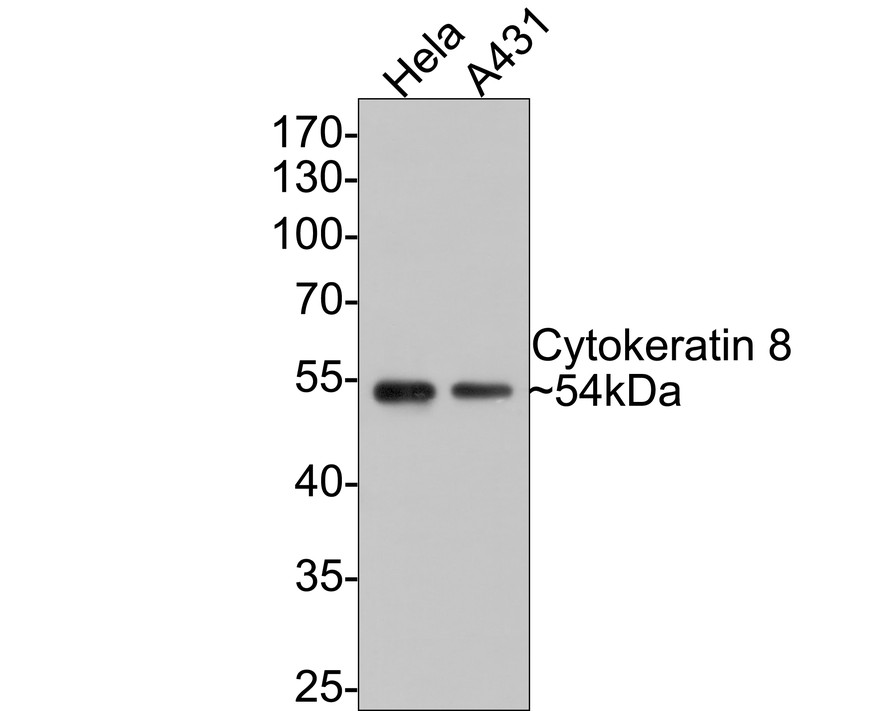
|
Fig1:
Western blot analysis of Cytokeratin 8 on different lysates with Rabbit anti-Cytokeratin 8 antibody (ET1608-32) at 1/1,000 dilution. Lane 1: Hela cell lysate (10 µg/Lane) Lane 2: A431 cell lysate (10 µg/Lane) Predicted band size: 54 kDa Observed band size: 54 kDa Exposure time: 30 seconds; 10% SDS-PAGE gel. Proteins were transferred to a PVDF membrane and blocked with 5% NFDM/TBST for 1 hour at room temperature. The primary antibody (ET1608-32) at 1/1,000 dilution was used in 5% NFDM/TBST at room temperature for 2 hours. Goat Anti-Rabbit IgG - HRP Secondary Antibody (HA1001) at 1:300,000 dilution was used for 1 hour at room temperature. |
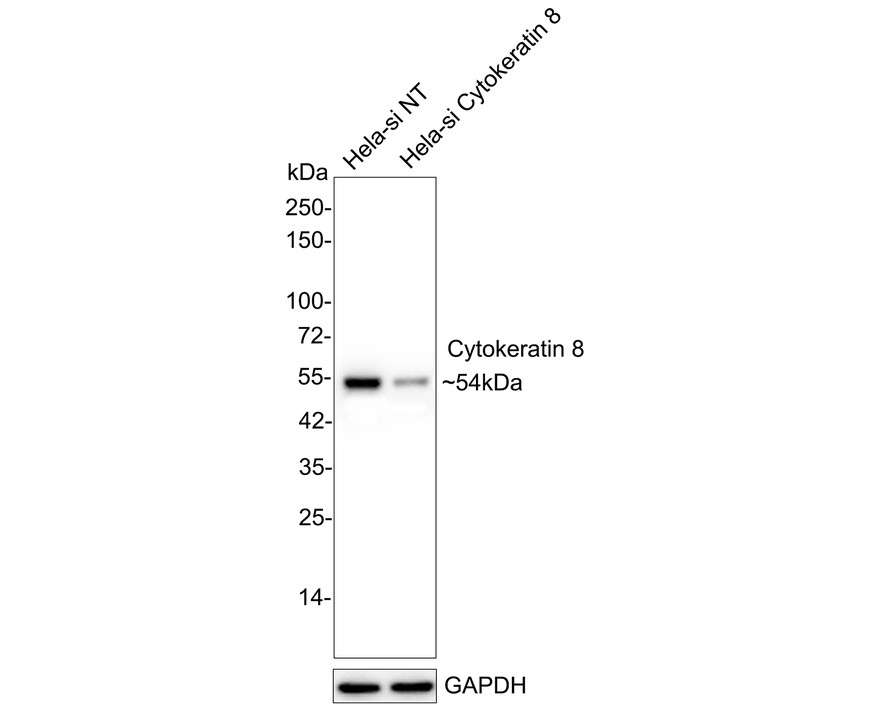
|
Fig2:
Western blot analysis of Cytokeratin 8 on different lysates with Rabbit anti-Cytokeratin 8 antibody (ET1608-32) at 1/2,000 dilution. Lane 1: Hela-si NT cell lysate (10 µg/Lane) Lane 2: Hela-si Cytokeratin 8 cell lysate (10 µg/Lane) Predicted band size: 54 kDa Observed band size: 54 kDa Exposure time: 24 seconds; 4-20% SDS-PAGE gel. ET1608-32 was shown to specifically react with Cytokeratin 8 in Hela-si NT cells. Weakened band was observed when Hela-si Cytokeratin 8 sample was tested. Hela-si NT and Hela-si Cytokeratin 8 samples were subjected to SDS-PAGE. Proteins were transferred to a PVDF membrane and blocked with 5% NFDM in TBST for 1 hour at room temperature. The primary antibody (ET1608-32, 1/2,000) and Loading control antibody (Rabbit anti-GAPDH, ET1601-4, 1/10,000) were used in 5% NFDM/TBST at 4℃ overnight. Goat Anti-rabbit IgG-HRP Secondary Antibody (HA1001) at 1:50,000 dilution was used for 1 hour at room temperature. |
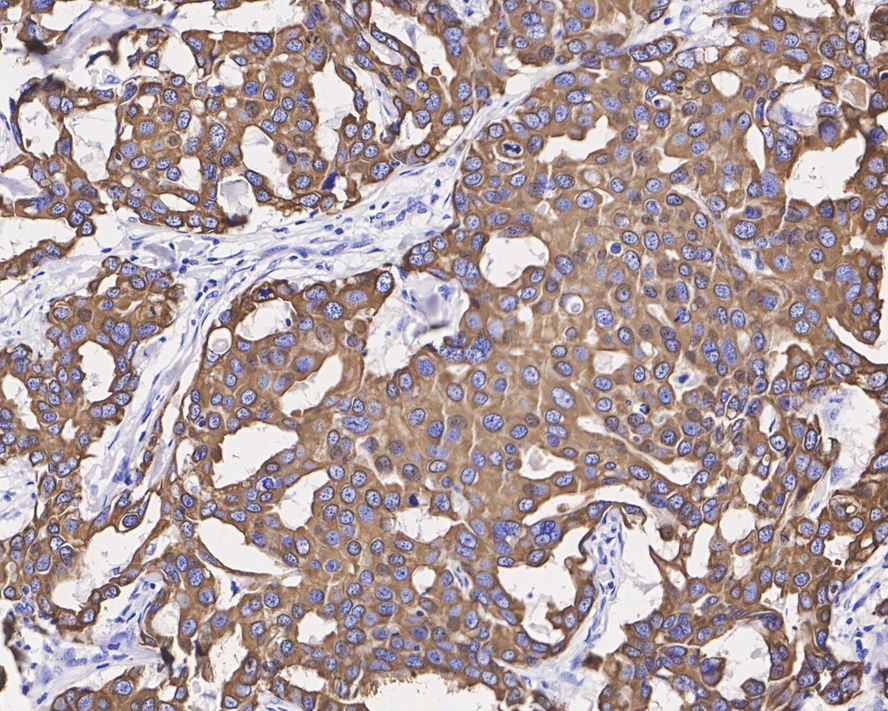
|
Fig3:
Immunohistochemical analysis of paraffin-embedded human breast carcinoma tissue with Rabbit anti-Cytokeratin 8 antibody (ET1608-32) at 1/1,500 dilution. The section was pre-treated using heat mediated antigen retrieval with Tris-EDTA buffer (pH 9.0) for 20 minutes. The tissues were blocked in 1% BSA for 20 minutes at room temperature, washed with ddH2O and PBS, and then probed with the primary antibody (ET1608-32) at 1/1,500 dilution for 1 hour at room temperature. The detection was performed using an HRP conjugated compact polymer system. DAB was used as the chromogen. Tissues were counterstained with hematoxylin and mounted with DPX. |
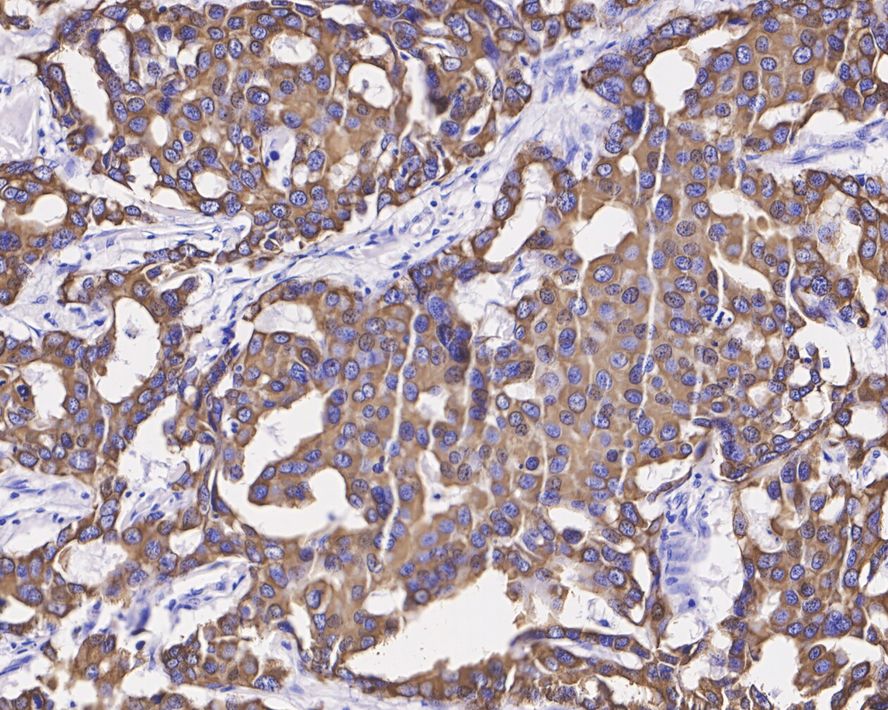
|
Fig4:
Immunohistochemical analysis of paraffin-embedded human breast carcinoma tissue with Rabbit anti-Cytokeratin 8 antibody (ET1608-32) at 1/1,500 dilution. The section was not undergone antigen retrieval. The tissues were blocked in 1% BSA for 20 minutes at room temperature, washed with ddH2O and PBS, and then probed with the primary antibody (ET1608-32) at 1/1,500 dilution for 1 hour at room temperature. The detection was performed using an HRP conjugated compact polymer system. DAB was used as the chromogen. Tissues were counterstained with hematoxylin and mounted with DPX. |

|
Fig5:
Immunohistochemical analysis of paraffin-embedded human breast tissue with Rabbit anti-Cytokeratin 8 antibody (ET1608-32) at 1/1,500 dilution. The section was not undergone antigen retrieval. The tissues were blocked in 1% BSA for 20 minutes at room temperature, washed with ddH2O and PBS, and then probed with the primary antibody (ET1608-32) at 1/1,500 dilution for 1 hour at room temperature. The detection was performed using an HRP conjugated compact polymer system. DAB was used as the chromogen. Tissues were counterstained with hematoxylin and mounted with DPX. |
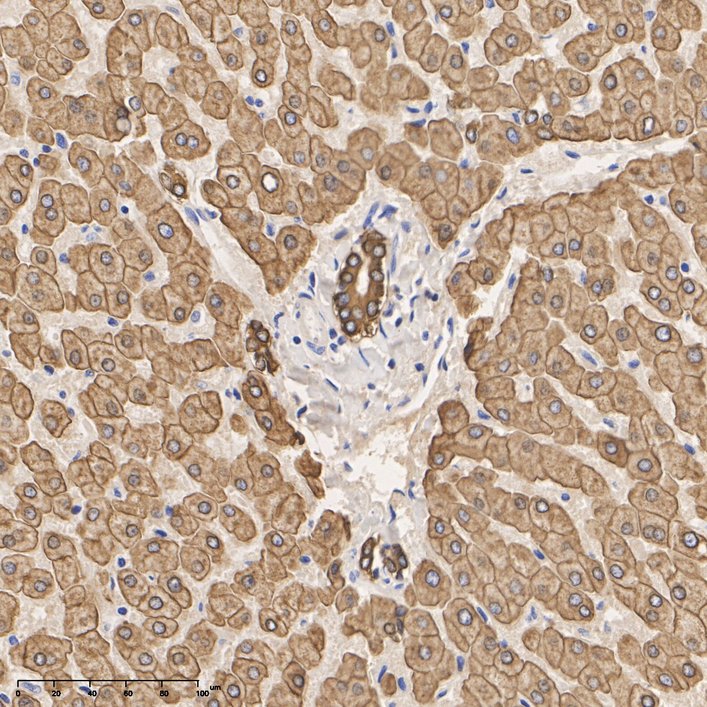
|
Fig6:
Immunohistochemical analysis of paraffin-embedded human liver tissue with Rabbit anti-Cytokeratin 8 antibody (ET1608-32) at 1/1,000 dilution. The section was pre-treated using heat mediated antigen retrieval with Tris-EDTA buffer (pH 9.0) for 20 minutes. The tissues were blocked in 1% BSA for 20 minutes at room temperature, washed with ddH2O and PBS, and then probed with the primary antibody (ET1608-32) at 1/1,000 dilution for 1 hour at room temperature. The detection was performed using an HRP conjugated compact polymer system. DAB was used as the chromogen. Tissues were counterstained with hematoxylin and mounted with DPX. |
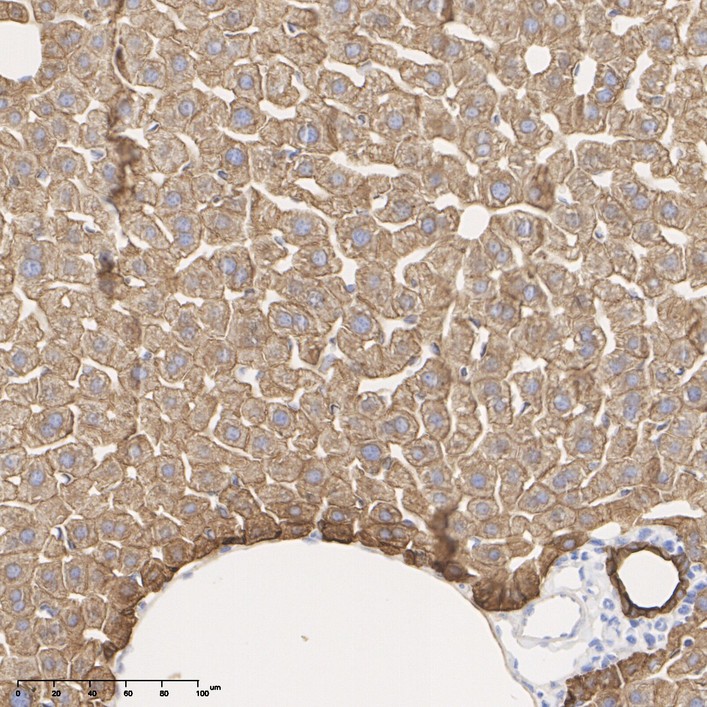
|
Fig7:
Immunohistochemical analysis of paraffin-embedded mouse liver tissue with Rabbit anti-Cytokeratin 8 antibody (ET1608-32) at 1/1,000 dilution. The section was pre-treated using heat mediated antigen retrieval with Tris-EDTA buffer (pH 9.0) for 20 minutes. The tissues were blocked in 1% BSA for 20 minutes at room temperature, washed with ddH2O and PBS, and then probed with the primary antibody (ET1608-32) at 1/1,000 dilution for 1 hour at room temperature. The detection was performed using an HRP conjugated compact polymer system. DAB was used as the chromogen. Tissues were counterstained with hematoxylin and mounted with DPX. |
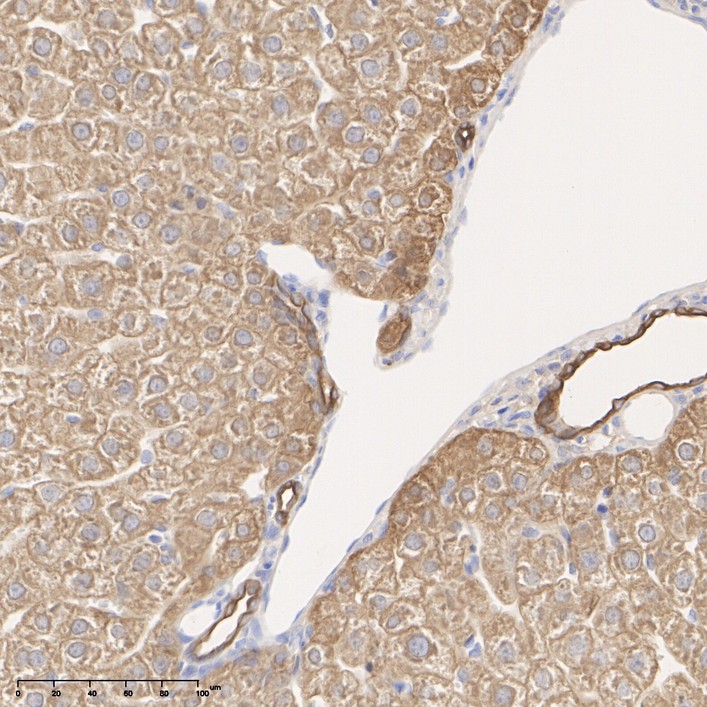
|
Fig8:
Immunohistochemical analysis of paraffin-embedded rat liver tissue with Rabbit anti-Cytokeratin 8 antibody (ET1608-32) at 1/1,000 dilution. The section was pre-treated using heat mediated antigen retrieval with Tris-EDTA buffer (pH 9.0) for 20 minutes. The tissues were blocked in 1% BSA for 20 minutes at room temperature, washed with ddH2O and PBS, and then probed with the primary antibody (ET1608-32) at 1/1,000 dilution for 1 hour at room temperature. The detection was performed using an HRP conjugated compact polymer system. DAB was used as the chromogen. Tissues were counterstained with hematoxylin and mounted with DPX. |
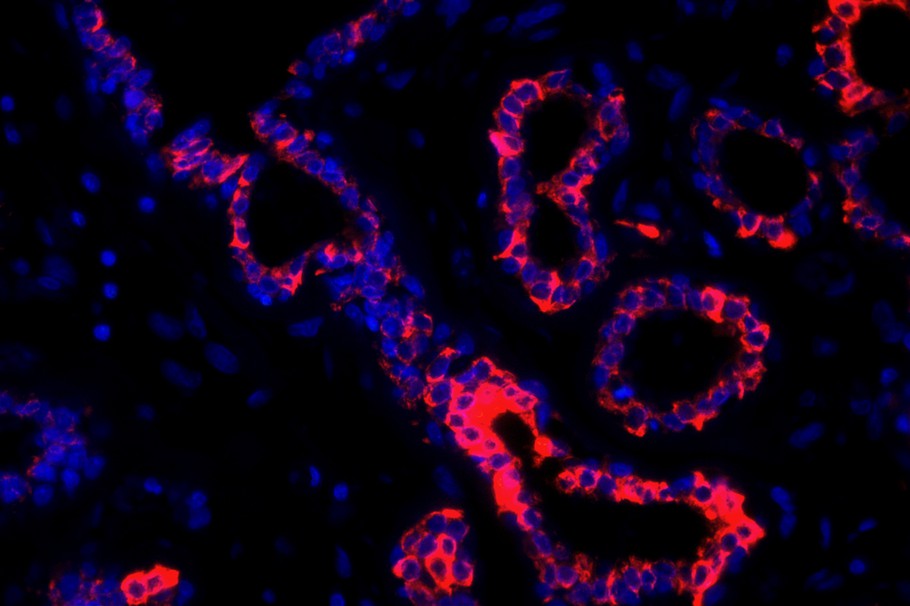
|
Fig9:
Immunofluorescence analysis of paraffin-embedded human breast tissue labeling Cytokeratin 8 (ET1608-32). The section was pre-treated using heat mediated antigen retrieval with Tris-EDTA buffer (pH 9.0) for 20 minutes. The tissues were blocked in 10% negative goat serum for 1 hour at room temperature, washed with PBS. And then probed with the primary antibodies Cytokeratin 8 (ET1608-32, red) at 1/400 dilution at +4℃ overnight, washed with PBS. Goat Anti-Rabbit IgG H&L (iFluor™ 594, HA1122) was used as the secondary antibodies at 1/1,000 dilution. Nuclei were counterstained with DAPI (blue). |

|
Fig10:
Immunofluorescence analysis of paraffin-embedded human liver tissue labeling Cytokeratin 8 (ET1608-32) and Vimentin (EM0401). The section was pre-treated using heat mediated antigen retrieval with Tris-EDTA buffer (pH 9.0) for 20 minutes. The tissues were blocked in 10% negative goat serum for 1 hour at room temperature, washed with PBS. And then probed with the primary antibodies Cytokeratin 8 (ET1608-32, red) at 1/50 dilution and Vimentin (EM0401, green) at 1/500 dilution at +4℃ overnight, washed with PBS. Goat Anti-Rabbit IgG H&L (iFluor™ 594, HA1122) and Goat Anti-Mouse IgG H&L (iFluor™ 488, HA1125) were used as the secondary antibodies at 1/1,000 dilution. Nuclei were counterstained with DAPI (blue). |
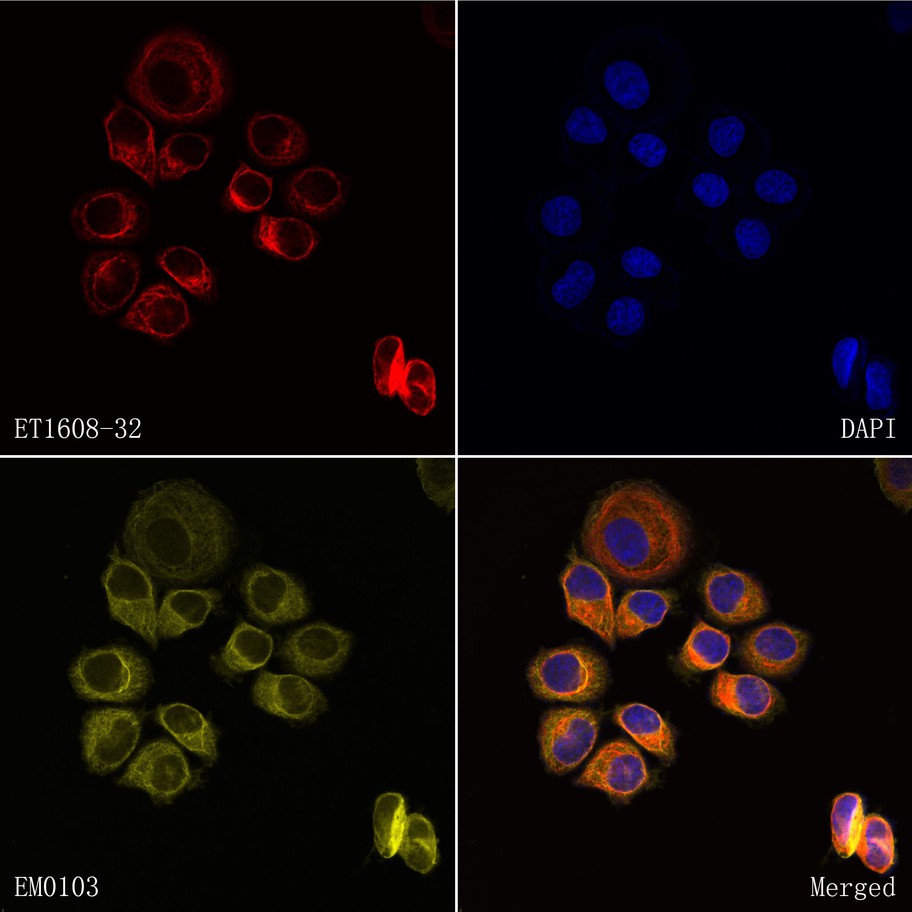
|
Fig11:
Immunocytochemistry analysis of SK-Br-3 cells labeling Cytokeratin 8 (ET1608-32). Cells were fixed in 4% paraformaldehyde and permeabilized with 0.05% Triton X-100 in PBS for 10 minutes, and then blocked with 2% negative goat serum for 15 minutes at room temperature. Cells were probed with the primary antibody Cytokeratin 8 (ET1608-32, red) at 1/50 dilution and Beta-tubulin (EM0103, yellow) at 1/500 dilution at +4℃ overnight. Goat Anti-Rabbit IgG H&L (iFluor™ 594, HA1122) and Goat Anti-Mouse IgG H&L (iFluor™ 488, HA1125) were used as the secondary antibodies at 1/1,000 dilution. Nuclei were counterstained with DAPI (blue). |
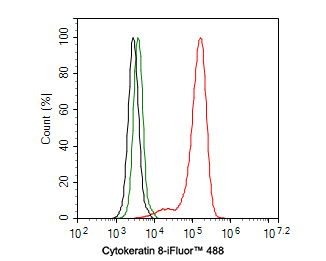
|
Fig12:
Flow cytometric analysis of HepG2 cells labeling Cytokeratin 8. Cells were fixed and permeabilized. Then stained with the primary antibody (ET1608-32, 1ug/ml) (red) compared with Rabbit IgG Isotype Control (green). After incubation of the primary antibody at +4℃ for an hour, the cells were stained with a iFluor™ 488 conjugate-Goat anti-Rabbit IgG Secondary antibody (HA1121) at 1/1,000 dilution for 30 minutes at +4℃. Unlabelled sample was used as a control (cells without incubation with primary antibody; black). |
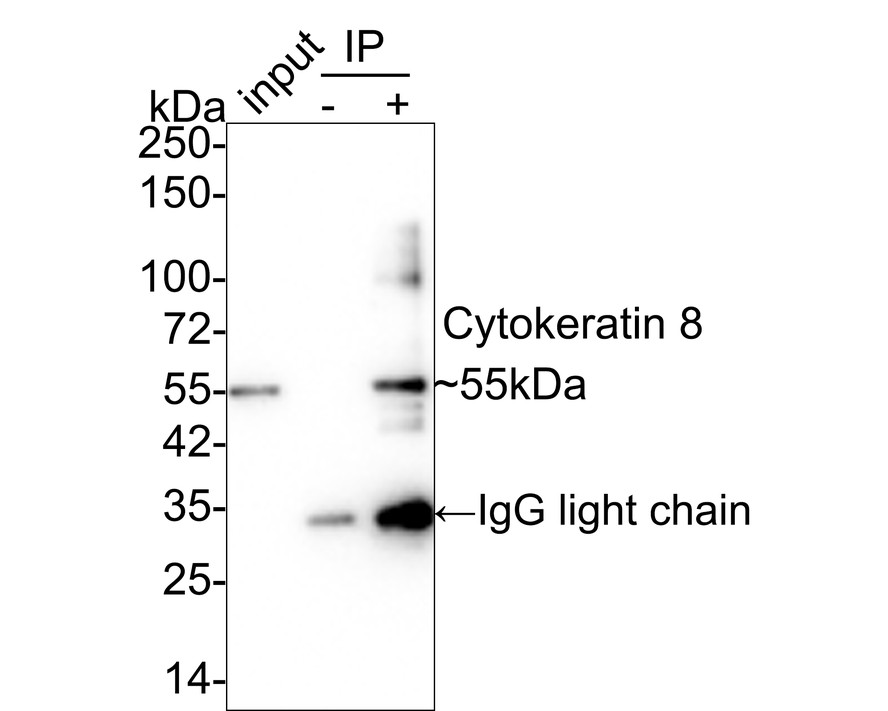
|
Fig13:
Cytokeratin 8 was immunoprecipitated in 0.2mg HeLa cell lysate with ET1608-32 at 2 µg/25 µl agarose. Western blot was performed from the immunoprecipitate using ET1608-32 at 1/2,000 dilution. Anti-Rabbit IgG for IP Nano-secondary antibody (NBI01H) at 1/5,000 dilution was used for 1 hour at room temperature. Lane 1: HeLa cell lysate (input) Lane 2: Rabbit IgG instead of ET1608-32 in HeLa cell lysate Lane 3: ET1608-32 IP in HeLa cell lysate Blocking/Dilution buffer: 5% NFDM/TBST Exposure time: 43 seconds |
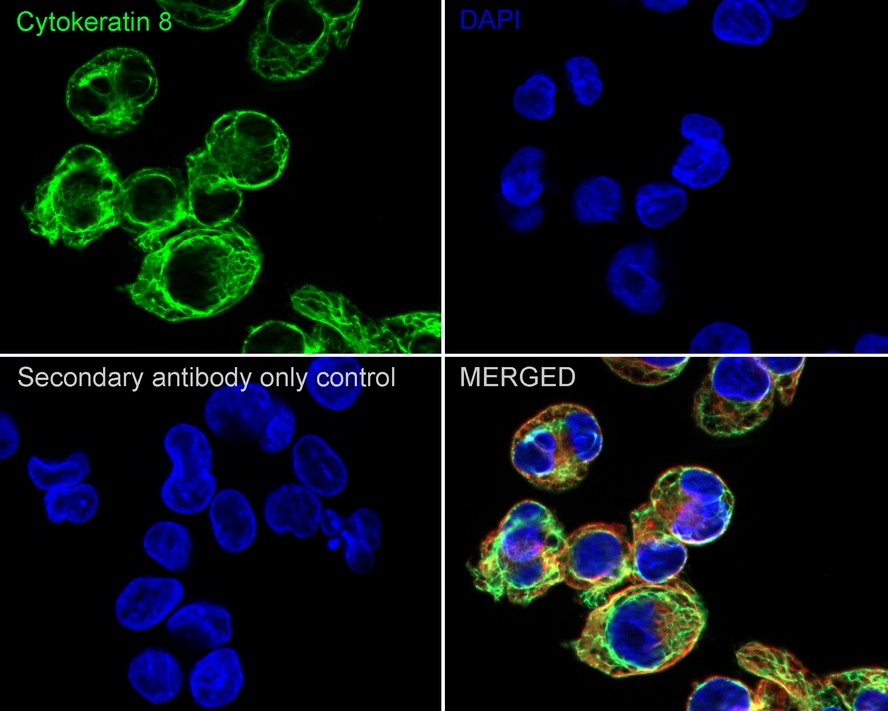
|
Fig14:
Immunocytochemistry analysis of HepG2 cells labeling Cytokeratin 8 with Rabbit anti-Cytokeratin 8 antibody (ET1608-32) at 1/100 dilution. Cells were fixed in 4% paraformaldehyde for 20 minutes at room temperature, permeabilized with 0.1% Triton X-100 in PBS for 5 minutes at room temperature, then blocked with 1% BSA in 10% negative goat serum for 1 hour at room temperature. Cells were then incubated with Rabbit anti-Cytokeratin 8 antibody (ET1608-32) at 1/100 dilution in 1% BSA in PBST overnight at 4 ℃. Goat Anti-Rabbit IgG H&L (iFluor™ 488, HA1121) was used as the secondary antibody at 1/1,000 dilution. PBS instead of the primary antibody was used as the secondary antibody only control. Nuclear DNA was labelled in blue with DAPI. Beta tubulin (M1305-2, red) was stained at 1/100 dilution overnight at +4℃. Goat Anti-Mouse IgG H&L (iFluor™ 594, HA1126) was used as the secondary antibody at 1/1,000 dilution. |
Note: All products are “FOR RESEARCH USE ONLY AND ARE NOT INTENDED FOR DIAGNOSTIC OR THERAPEUTIC USE”.